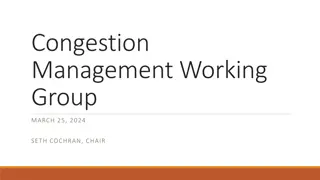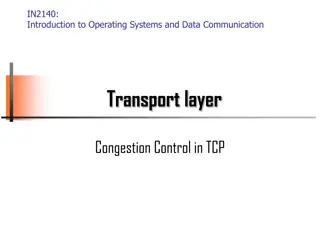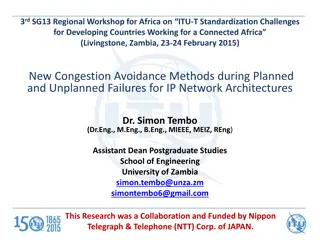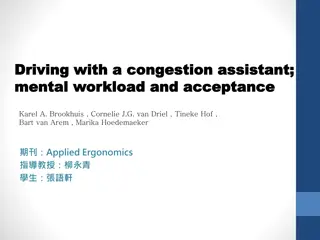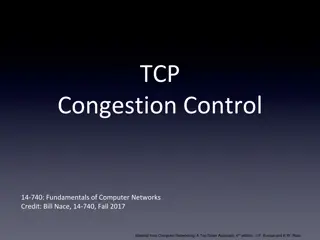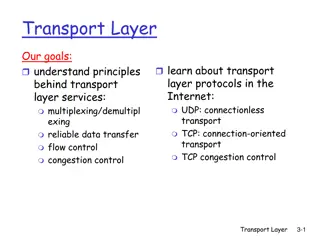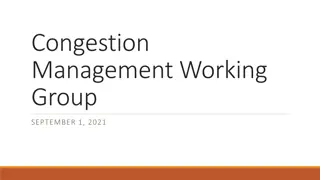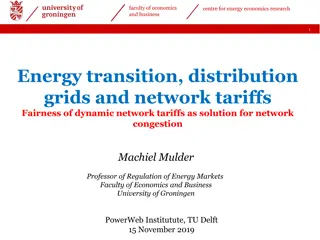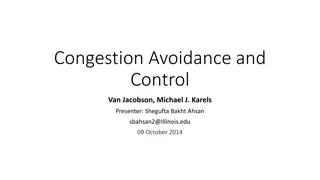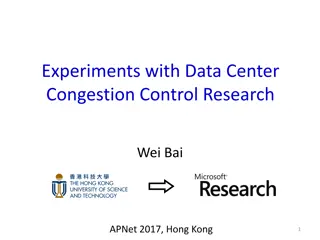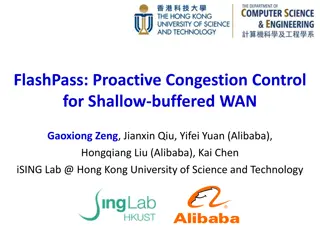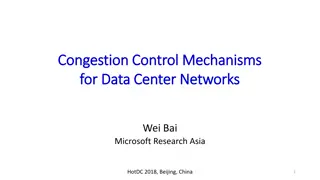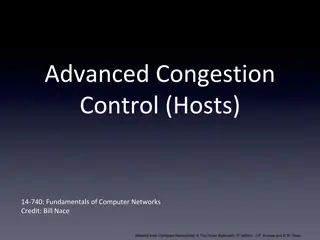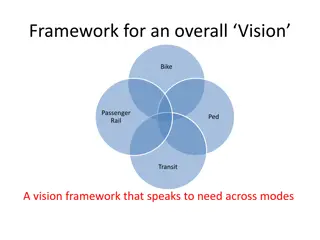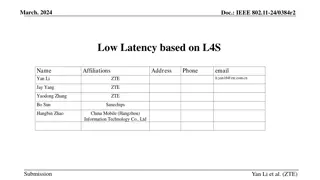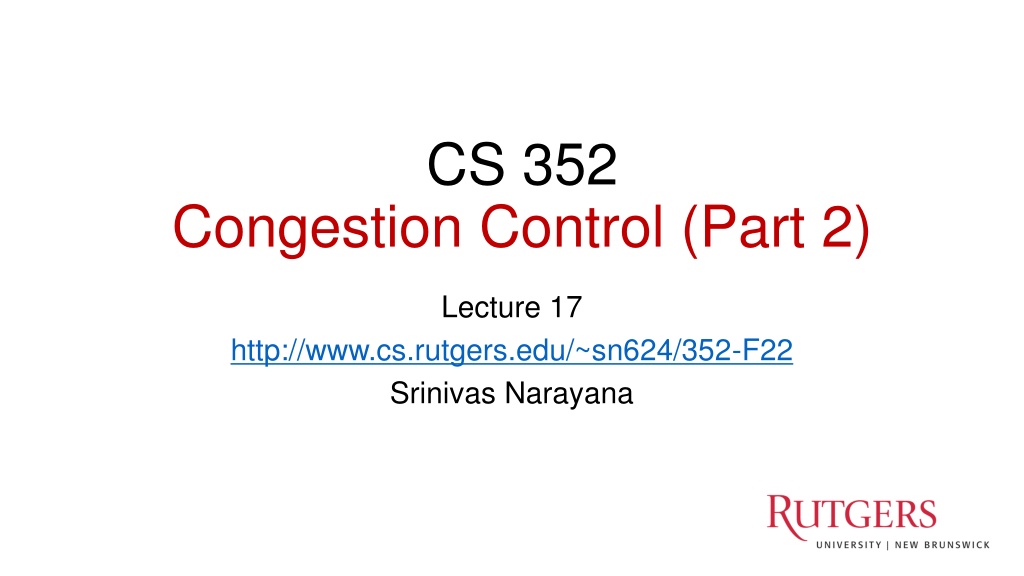
Understanding Congestion Control in TCP Networks
Explore the concepts of congestion control in TCP networks, including bottleneck identification, adapting data transmission, steady state operation, and achieving efficient throughput. Learn about congestion windows, interaction between flow and congestion control, and methods to reach a steady state in TCP connections.
Uploaded on | 0 Views
Download Presentation

Please find below an Image/Link to download the presentation.
The content on the website is provided AS IS for your information and personal use only. It may not be sold, licensed, or shared on other websites without obtaining consent from the author. If you encounter any issues during the download, it is possible that the publisher has removed the file from their server.
You are allowed to download the files provided on this website for personal or commercial use, subject to the condition that they are used lawfully. All files are the property of their respective owners.
The content on the website is provided AS IS for your information and personal use only. It may not be sold, licensed, or shared on other websites without obtaining consent from the author.
E N D
Presentation Transcript
CS 352 Congestion Control (Part 2) Lecture 17 http://www.cs.rutgers.edu/~sn624/352-F22 Srinivas Narayana 1
Multiple locations for bottlenecks application process sender recv() Flow Control TCP socket receiver buffers Congestion Control TCP code What s the bottleneck? How to adapt how much data to keep in flight? from sender Distributed algorithm converging to an efficient and fair outcome receiver Sense and React TCP congestion control algorithm Steady state? Loss, Congestion window, sending rate ACKs, etc. H C How to get to steady state? Bottleneck link Knobs Signals
Congestion window The sender maintains an estimate of the amount of in-flight data needed to keep the pipe full without congesting it. This estimate is called the congestion window (cwnd) Recall: There is a relationship between the sending rate (throughput) and the sender s window: sender transmits a window s worth of data over an RTT duration Rate = window / RTT
Interaction b/w flow & congestion control Use window = min(congestion window, receiver advertised window) Overwhelm neither the receiver nor network links & routers Window <= Congestion window (congestion control) Window <= Advertised window (flow control) Sender s view: 0 3 1 0 4 1 2 5 7 6 Last cumulative ACK ed seq # Last transmitted seq #
Review: Goal of steady state operation (2) Keep transmissions over the bottleneck link back to back Send packet burst (as allowed by window) Receive data packet Data (1) Keep transmissions ACK-clocked: Send new data on ACK Sender Receiver Receive ACK Send ACK ACKs
Review: Getting to steady: TCP New Reno Say MSS = 1 KByte Adjusting closer to steady state: different methods Congestion avoidance Packet drops/ RTO Loss occurs at cwnd = 54K Loss occurs at cwnd = 40K 54 MSS Set ssthresh to 27 MSS Congestion Window Set ssthresh to 20 MSS 1K Time
TCP BBR: finding the bottleneck link rate 1. Send data at a specific rate Data gets across the bottleneck at the bottleneck link rate. 2. Receive data packet Use ACK receive rate to determine sending rate Data Sender Receiver 4. Measure rate of incoming ACKs 3. Send ACK ACKs
TCP BBR: finding the bottleneck link rate Assuming that the link rate of the bottleneck == the rate of data getting across the bottleneck link == the rate of data getting to the receiver == the rate at which ACKs are generated by the receiver == the rate at which ACKs reach the sender Measuring ACK rate provides an estimate of bottleneck link rate BBR: Send at the maximum ACK rate measured in the recent past Update max with new bottleneck rate estimates, i.e., larger ACK rate Forget estimates last measured a long time ago Incorporated into a rate filter
TCP BBR: Adjustments by gain cycling BBR periodically increases its sending rate by a gain factor to see if the link rate has increased (e.g., due to a path change) Steady state operation: constant sending rate Gain cycle Last max ACK rate was measured a while ago. Forget it & use a more recent max ACK rate Sending rate Filter No change in ACK rate Detect higher ACK rate: Update sending rate Bottleneck link rate increase Bottleneck link rate decrease Time
Steady state cwnd for a single flow Suppose the bottleneck link has rate C Suppose the propagation round-trip delay (propRTT) between sender and receiver is T Ignore transmission delays for this example; Assume steady state: highest sending rate with no bottleneck congestion Q: how much data is in flight over a single RTT? C * T data i.e., amount of data unACKed at any point in time ACKs take time T to arrive (without any queueing). In the meantime, sender is transmitting at rate C
The Bandwidth-Delay Product C * T = bandwidth-delay product: The amount of data in flight for a sender transmitting at the ideal rate during the ideal round-trip delay of a packet Note: this is just the amount of data on the pipe Data C * T
The Bandwidth-Delay Product Q: What happens if cwnd > C * T? i.e., where are the rest of the in-flight packets? A: Waiting at the bottleneck router queues Data C * T
Router buffers and the max cwnd Router buffer memory is finite: queues can only be so long If the router buffer size is B, there is at most B data waiting in the queue If cwnd increases beyond C * T + B, data is dropped! B Data C * T
Summary Bandwidth-Delay Product (BDP) governs the window size of a single flow at steady state The bottleneck router buffer size governs how much the cwnd can exceed the BDP before packet drops occur BDP is the ideal desired window size to use the full bottleneck link, without any queueing. Accommodating flow control, also the min socket buffer size to use the bottleneck link fully
Detecting and Reacting to Packet Loss
Detecting packet loss So far, all the algorithms we ve studied have a coarse loss detection mechanism: RTO timer expiration Let the RTO expire, drop cwnd all the way to 1 MSS Analogy: you re driving a car You re waiting until the next car in front is super close to you (RTO) and then hitting the brakes really hard (set cwnd := 1) Q: Can you see obstacles from afar and slow down proportionately? That is, can the sender see packet loss coming in advance? And reduce cwnd more gently?
Can we detect loss earlier than RTO? Key idea: use the information in the ACKs. How? Suppose successive (cumulative) ACKs contain the same ACK# Also called duplicate ACKs Occur when network is reordering packets, or one (but not most) packets in the window were lost Reduce cwnd when you see many duplicate ACKs Consider many dup ACKs a strong indication that packet was lost Default threshold: 3 dup ACKs, i.e., triple duplicate ACK Make cwnd reduction gentler than setting cwnd = 1; recover faster
Fast Retransmit & Fast Recovery
Distinction: In-flight versus window So far, window and in-flight referred to the same data Fast retransmit & fast recovery differentiate the two notions inflight = 3 cwnd = 6 Sender s view: 0 0 3 3 1 1 4 4 0 0 1 1 2 5 2 5 7 7 6 6 Triple duplicate ACKs (assume subsequent 3 pieces of data were successfully received) inflight is the data currently believed to be in flight. Last cumulative ACK ed seq # Last transmitted seq # cwnd is the interval between the last cumulatively ACK ed seq# and the last transmitted seq#
TCP fast retransmit (RFC 2581) The fact that ACKs are coming means that data is getting delivered to the receiver, albeit with some loss. Note: Before the dup ACKs arrive, we assume inflight = cwnd TCP sender does two actions with fast retransmit
TCP fast retransmit (RFC 2581) (1) Reduce the cwnd and in-flight gently Don t drop cwnd all the way down to 1 MSS Reduce the amount of in-flight data multiplicatively Set inflight inflight / 2 That is, set cwnd = (inflight / 2) + 3MSS This step is called multiplicative decrease Algorithm also sets ssthresh to inflight / 2
TCP fast retransmit (RFC 2581) Example: Suppose cwnd and inflight (before triple dup ACK) were both 8 MSS. After triple dup ACK, reduce inflight to 4 MSS Assume 3 of those 8 MSS no longer in flight; set cwnd = 7 MSS inflight = 4 cwnd = 7 cwnd = inflight = 8 0 5 3 1 0 4 1 2 5 3 7 0 4 6 1 2 7 6 5 Assumed not in flight (dup ACK) Last cumulative ACK ed seq #
TCP fast retransmit (RFC 2581) (2) The seq# from dup ACKs is immediately retransmitted That is, don t wait for an RTO if there is sufficiently strong evidence that a packet was lost
TCP fast recovery (RFC 2581) Sender keeps the reduced inflight until a new ACK arrives New ACK: an ACK for the seq# that was just retransmitted May also include the (three or more) pieces of data that were subsequently delivered to generate the duplicate ACKs Conserve packets in flight: transmit some data over lossy periods (rather than no data, which would happen if cwnd := 1)
TCP fast recovery (RFC 2581) Keep incrementing cwnd by 1 MSS for each dup ACK cwnd = 6 inflight = 3 0 5 3 1 0 4 1 2 5 3 7 0 4 6 1 2 7 6 5 Assumed not in flight (dup ACK) Last cumulative ACK ed seq #
TCP fast recovery (RFC 2581) Keep incrementing cwnd by 1 MSS for each dup ACK cwnd = 7 inflight = 3 0 5 3 1 0 4 1 2 5 3 7 0 4 6 1 2 7 6 Assumed not in flight (dup ACK) Last cumulative ACK ed seq #
TCP fast recovery (RFC 2581) Keep incrementing cwnd by 1 MSS for each dup ACK cwnd = 8 inflight = 3 0 5 3 1 0 4 1 2 5 3 7 0 4 6 1 2 7 6 Assumed not in flight (dup ACK) Last cumulative ACK ed seq #
TCP fast recovery (RFC 2581) Eventually a new ACK arrives, acknowledging the retransmitted data and all data in between Deflate cwnd to half of cwnd before fast retransmit. cwnd and inflight are aligned and equal once again Perform additive increase from this point! cwnd = 3 inflight = 3 0 5 3 1 0 4 1 2 5 3 7 0 4 6 1 2 7 6 Last cumulative ACK ed seq # New ACK acknowledged this data
Additive Increase/Multiplicative Decrease Say MSS = 1 KByte Default ssthresh = 64KB = 64 MSS Triple duplicate ACK Perceived loss occurs at cwnd = 80K Switch to additive increase at cwnd= ssthresh = 64K New ACK RTO Multiplicative decrease In-flight data RTO: window drops all the way to 1 MSS (2) Set inflight =ssthresh = 40K Fast retransmit: (1) retransmit dup-ACKed segment Fast recovery keeps inflight stable until new ACK 1K Time
TCP New Reno performs additive increase and multiplicative decrease of congestion window. In short, we often refer to this as AIMD. Multiplicative decrease is a part of all TCP algorithms, including BBR. [It is necessary for fairness across TCP flows.]
Summary: TCP loss detection & reaction Don t wait for an RTO and then set the cwnd to 1 MSS Tantamount to waiting to get super close to the car in front and then jamming the brakes really hard Instead, react proportionately by sensing pkt loss in advance Fast Retransmit Triple dup ACK: sufficiently strong signal that network has dropped data, before RTO Immediately retransmit data Multiplicatively decrease in- flight data to half of its value Fast Recovery Maintain this reduced amount of in-flight data as long as dup ACKs arrive Data is successfully getting delivered When new ACK arrives, do additive increase from there on


